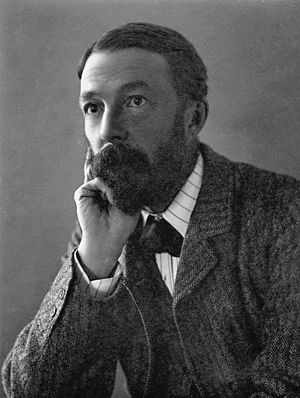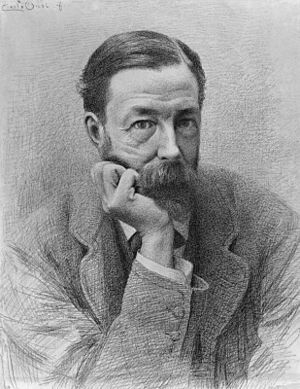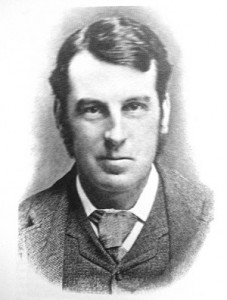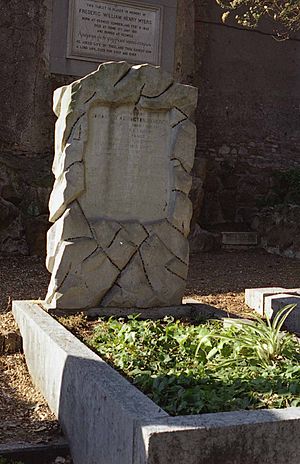John Addington Symonds facts for kids
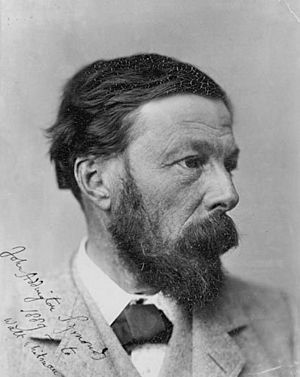
John Addington Symonds Jr. (/ˈsɪməndz/; 5 October 1840 – 19 April 1893) was an English poet and literary critic. A cultural historian, he was known for his work on the Renaissance, as well as numerous biographies of writers and artists.
Early life and education
Symonds was born at Bristol, England, in 1840. His father, the physician John Addington Symonds (1807–1871), was the author of Criminal Responsibility (1869), The Principles of Beauty (1857) and Sleep and Dreams. The younger Symonds, considered delicate, did not take part in games at Harrow School after the age of 14, and he showed no particular promise as a scholar.
Symonds moved to Clifton Hill House at the age of ten, an event which he believed had a large and beneficial impact towards his health and spiritual development. Symonds's delicate condition continued, and as a child he suffered from nightmares in which corpses in and under his bed prompted sleepwalking; on one such occasion he was almost drowned when, sleepwalking in the attic of Clifton Hill House, he reached a cistern of rainwater. According to Symonds, an angel with "blue eyes and wavy, blonde hair" woke him and brought him to safety; this figure frequented Symonds's dreams.
In the autumn of 1858, Symonds went to Balliol College, Oxford, as a commoner but was elected to an exhibition in the following year. In spring of that same year, he fell in love with William Fear Dyer (1843–1905), a Bristol choirboy three years younger. Their relationship that lasted a year, until broken up by Symonds. The friendship continued for several years afterwards, until at least 1864. Dyer became organist and choirmaster of St Nicholas' Church, Bristol.
At Oxford University, Symonds became engaged in his studies and began to demonstrate his academic ability. In 1860, he took a first in Mods and won the Newdigate prize with a poem on "The Escorial"; in 1862 he obtained a first in Literae Humaniores, and in 1863 won the Chancellor's English Essay.
In 1862, Symonds was elected to an open fellowship at the conservative Magdalen. He made friends with a C. G. H. Shorting, whom he took as a private pupil. When Symonds refused to help Shorting gain admission to Magdalen, the younger man wrote to school officials alleging "that I [Symonds] had supported him in his pursuit of the chorister Walter Thomas Goolden (1848–1901), that I shared his habits and was bent on the same path." Although Symonds was officially cleared of any wrongdoing, he suffered a breakdown from the stress and shortly thereafter left the university for Switzerland.
Personal life
In Switzerland, he met Janet Catherine North (sister of botanical artist Marianne North, 1830–1890). They married at Hastings on 10 November 1864. They settled in London and had four daughters: Janet (born 1865), Charlotte (born 1867), Margaret (Madge) (born 1869) and Katharine (born 1875; she was later honoured for her writing as Dame Katharine Furse). Edward Lear wrote "The Owl and the Pussycat" for the three-year-old Janet.
While in Clifton in 1868, Symonds met Norman Moor (January 10, 1851 – March 6, 1895), a youth about to go up to Oxford, who became his pupil.
Career
Symonds intended to study law, but his health again broke down and forced him to travel. Returning to Clifton, he lectured there, both at the college and ladies' schools. From his lectures, he prepared the essays in his Introduction to the Study of Dante (1872) and Studies of the Greek Poets (1873–1876).
Meanwhile, he was occupied with his major work, Renaissance in Italy, which appeared in seven volumes at intervals between 1875 and 1886. Since his prize essay on the Renaissance at Oxford, Symonds had wanted to study it further and emphasise the reawakening of art and literature in Europe. His work was interrupted by serious illness. In 1877 his life was in danger. His recovery at Davos Platz led him to believe this was the only place where he was likely to enjoy life.
He practically made his home at Davos, and wrote about it in Our Life in the Swiss Highlands (1891). Symonds became a citizen of the town; he took part in its municipal business, made friends with the peasants, and shared their interests. There he wrote most of his books: biographies of Percy Bysshe Shelley (1878), Philip Sidney (1886), Ben Jonson (1886) and Michelangelo (1893), several volumes of poetry and essays, and a translation of the Autobiography of Benvenuto Cellini (1887).
There, too, he completed his study of the Renaissance, the work for which he is chiefly remembered. He was feverishly active throughout his life. Considering his poor health, his productivity was remarkable. Two works, a volume of essays, In the Key of Blue, and a monograph on Walt Whitman, were published in the year of his death. His activity was unbroken to the last.
He had a passion for Italy, and for many years resided during the autumn in the house of his friend, Horatio F. Brown, on the Zattere, in Venice. In 1891 he made an effort to visit Karl Heinrich Ulrichs in L'Aquila. He died in Rome and was buried close to the grave of Percy Bysshe Shelley.
Legacy
Symonds left his papers and his autobiography in the hands of Brown, who wrote an expurgated biography in 1895, which Edmund Gosse further corrected before publication. In 1926, upon coming into the possession of Symonds's papers, Gosse burned everything except the memoirs, to the dismay of Symonds's granddaughter.
Symonds was morbidly introspective, but with a capacity for action. In Talks and Talkers, the contemporary writer Robert Louis Stevenson described Symonds (known as "Opalstein" in Stevenson's essay) as "the best of talkers, singing the praises of the earth and the arts, flowers and jewels, wine and music, in a moonlight, serenading manner, as to the light guitar." Beneath his good fellowship, he was a melancholic.
This side of his nature is revealed in his gnomic poetry, and particularly in the sonnets of his Animi Figura (1882). He portrayed his own character with great subtlety. His poetry is perhaps rather that of the student than of the inspired singer, but it has moments of deep thought and emotion.
It is, indeed, in passages and extracts that Symonds appears at his best. Rich in description, full of "purple patches", his work lacks the harmony and unity essential to the conduct of philosophical argument. His translations are among the finest in the language; here his subject was found for him, and he was able to lavish on it the wealth of colour and quick sympathy which were his characteristics.
Works
- The Renaissance. An Essay (1863)
- Miscellanies by John Addington Symonds, M.D.,: Selected and Edited with an Introductory Memoir, by His Son (1871)
- Studies of the Greek Poets, 2 vol. (1873, 1876)
- Renaissance in Italy, 7 vol. (1875–86)
- Shelley (1878)
- Sketches in Italy and Greece (London, Smith and Elder 1879)
- Sketches and Studies in Italy (London, Smith and Elder 1879)
- Animi Figura (1882)
- Sketches in Italy (Selections prepared by Symonds, arranged, so as to, in his own words in a Prefatory Note, "adapt itself to the use of travellers rather than of students"; Leipzig, Bernhard Tauchnitz 1883)
- A Problem in Greek Ethics (1883)
- Shakespere's Predecessors in the English Drama (1884)
- New Italian Sketches (Bernard Tauchnitz: Leipzig, 1884)
- Wine, Women, and Song. Medieval Latin Students' Songs (1884) English translations/paraphrases.
- Autobiography of Benvenuto Cellini (1887) An English translation.
- A Problem in Modern Ethics (1891)
- Our Life in the Swiss Highlands (1892) (with his daughter Margaret Symonds as coauthor)
- Essays: Speculative and Suggestive (1893)
- In the Key of Blue (1893)
- The Life of Michelangelo Buonarroti (1893)
- Walt Whitman. A Study (1893)
See also
- Uranian poetry


